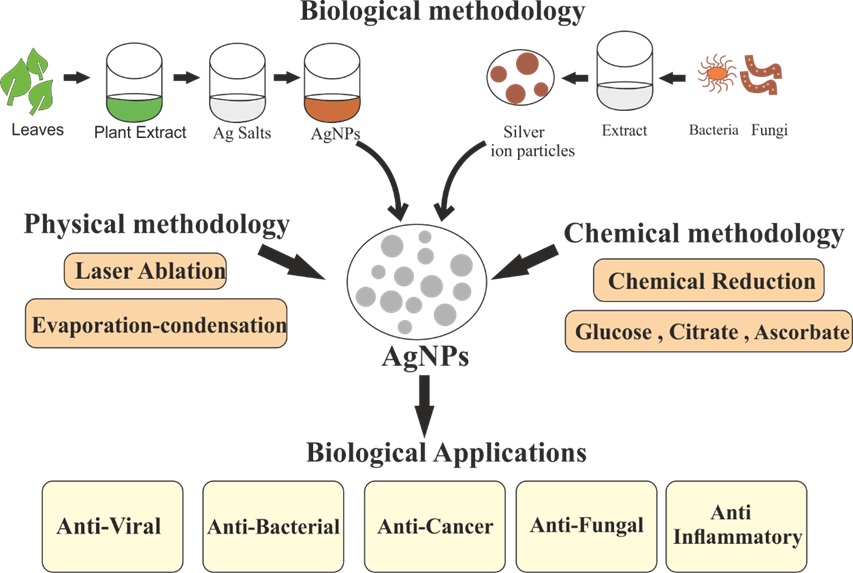Advances in Synthesis Approaches and Biological Applications of Silver Nanoparticles: A Systematic Review

DOI:
https://doi.org/10.54060/a2zjournals.jase.72Keywords:
Nanoparticles, silver nanoparticles, biological approachAbstract
The need for silver nanoparticlesor AgNPs is rising quickly across a wide range of industries, including healthcare, pharmaceuticals, food, cosmetics, and medicine. Owing to its many functions, it has been applied in a variety of settings, including the food industry, medical devices, housekeeping, wound dressing, orthopaedics, and diagnostics. It has also been utilised as an anticancer agent. These microscopic particles can potentially be put to use for a plenty of purposes and have the ability to alter their physical, chemical, and biological properties. Three discrete approaches emerge for preparing AgNPs: chemical, biological, and physical. Of the three approaches, the biological approach is proven to be the most straightforward, environmentally friendly, marketable, and one-step procedure; it also requires the least amount of force, high pressure, or temperature. Ag NPs have been shown to halt the expansion and proliferation of numerous bacteria by linkingAg/Ag+utilizing the biomolecules that thrive in the cells of microbes.
Downloads
References
A. M. Fayaz, K. Balaji, M. Girilal, R. Yadav, P. T. Kalaichelvan, and R. Venketesan, “Biogenic synthesis of silver nanoparticles and their synergistic effect with antibiotics: a study against gram-positive and gram-negative bacteria,” Nanomedicine: Nanotechnology, Biology and Medicine, vol. 6, no. 1, pp. 103–109, Feb. 2010, doi: 10.1016/j.nano.2009.04.006.
Z. Huang et al., “Toxicity mechanisms and synergies of silver nanoparticles in 2,4-dichlorophenol degradation by Phan-erochaete chrysosporium,” Journal of Hazardous Materials, vol. 321, pp. 37–46, Jan. 2017, doi: 10.1016/j.jhazmat.2016.08.075.
A. Kumar, P. K. Vemula, P. M. Ajayan, and G. John, “Silver-nanoparticle-embedded antimicrobial paints based on vegeta-ble oil,” Nature Materials, vol. 7, no. 3, pp. 236–241, Jan. 2008, doi: 10.1038/nmat2099.
K. M. M. Abou El-Nour, A. Eftaiha, A. Al-Warthan, and R. A. A. Ammar, “Synthesis and applications of silver nanoparti-cles,” Arabian Journal of Chemistry, vol. 3, no. 3, pp. 135–140, Jul. 2010, doi: 10.1016/j.arabjc.2010.04.008.
S. Ahmed, M. Ahmad, B. L. Swami, and S. Ikram, “A review on plants extract mediated synthesis of silver nanoparticles for antimicrobial applications: A green expertise,” Journal of Advanced Research, vol. 7, no. 1, pp. 17–28, Jan. 2016, doi: 10.1016/j.jare.2015.02.007.
T. Tsuji, K. Iryo, Y. Nishimura, and M. Tsuji, “Preparation of metal colloids by a laser ablation technique in solution: influ-ence of laser wavelength on the ablation efficiency (II),” Journal of Photochemistry and Photobiology A: Chemistry, vol. 145, no. 3, pp. 201–207, Dec. 2001, doi: 10.1016/s1010-6030(01)00583-4.
S. Gurunathan, J. H. Park, J. W. Han, and J.-H. Kim, “Comparative assessment of the apoptotic potential of silver nanopar-ticles synthesized by Bacillus tequilensis and Calocybe indica inMDA-MB-231 human breast cancer cells: targeting p53 for anticancer therapy,” International Journal of Nanomedicine, p. 4203, Jun. 2015, doi: 10.2147/ijn.s83953.
H. Lange, “Comparative Test of Methods to Determine Particle Size and Particle Size Distribution in the Submicron Range,” Particle & Particle Systems Characterization, vol. 12, no. 3, pp. 148–157, Jun. 1995, doi: 10.1002/ppsc.19950120307.
S. Gurunathan, J. W. Han, E. Kim, J. H. Park, and J.-H. Kim, “Reduction of graphene oxide by resveratrol: a novel and sim-ple biological method for the synthesis of an effective anticancer nanotherapeutic molecule,” International Journal of Nanomedicine, p. 2951, Apr. 2015, doi: 10.2147/ijn.s79879.
K. E. Sapsford, K. M. Tyner, B. J. Dair, J. R. Deschamps, and I. L. Medintz, “Analyzing Nanomaterial Bioconjugates: A Review of Current and Emerging Purification and Characterization Techniques,” Analytical Chemistry, vol. 83, no. 12, pp. 4453–4488, May 2011, doi: 10.1021/ac200853a.
K. M. M. Abou El-Nour, A. Eftaiha, A. Al-Warthan, and R. A. A. Ammar, “Synthesis and applications of silver nanoparti-cles,” Arabian Journal of Chemistry, vol. 3, no. 3, pp. 135–140, Jul. 2010, doi: 10.1016/j.arabjc.2010.04.008.
P. Banerjee, M. Satapathy, A. Mukhopahayay, and P. Das, “Leaf extract mediated green synthesis of silver nanoparticles from widely available Indian plants: synthesis, characterization, antimicrobial property and toxicity analysis,” Biore-sources and Bioprocessing, vol. 1, no. 1, Jul. 2014, doi: 10.1186/s40643-014-0003-y.
S. Gurunathan et al., “Biosynthesis, purification and characterization of silver nanoparticles using Escherichia coli,” Col-loids and Surfaces B: Biointerfaces, vol. 74, no. 1, pp. 328–335, Nov. 2009, doi: 10.1016/j.colsurfb.2009.07.048.
A. Albanese, P. S. Tang, and W. C. W. Chan, “The Effect of Nanoparticle Size, Shape, and Surface Chemistry on Biological Systems,” Annual Review of Biomedical Engineering, vol. 14, no. 1, pp. 1–16, Aug. 2012, doi: 10.1146/annurev-bioeng-071811-150124.
L. Kvítek et al., “Effect of Surfactants and Polymers on Stability and Antibacterial Activity of Silver Nanoparticles (NPs),” The Journal of Physical Chemistry C, vol. 112, no. 15, pp. 5825–5834, Mar. 2008, doi: 10.1021/jp711616v.
I. Sondi and B. Salopek-Sondi, “Silver nanoparticles as antimicrobial agent: a case study on E. coli as a model for Gram-negative bacteria,” Journal of Colloid and Interface Science, vol. 275, no. 1, pp. 177–182, Jul. 2004, doi: 10.1016/j.jcis.2004.02.012.
S. Pal, Y. K. Tak, and J. M. Song, “Does the Antibacterial Activity of Silver Nanoparticles Depend on the Shape of the Na-noparticle? A Study of the Gram-Negative Bacterium Escherichia coli,” Applied and Environmental Microbiology, vol. 73, no. 6, pp. 1712–1720, Mar. 2007, doi: 10.1128/aem.02218-06.
J. S. Kim et al., “Antimicrobial effects of silver nanoparticles,” Nanomedicine: Nanotechnology, Biology and Medicine, vol. 3, no. 1, pp. 95–101, Mar. 2007, doi: 10.1016/j.nano.2006.12.001.
S. Eckhardt, P. S. Brunetto, J. Gagnon, M. Priebe, B. Giese, and K. M. Fromm, “Nanobio Silver: Its Interactions with Peptides and Bacteria, and Its Uses in Medicine,” Chemical Reviews, vol. 113, no. 7, pp. 4708–4754, Mar. 2013, doi: 10.1021/cr300288v.
K.-J. Kim et al., “Antifungal activity and mode of action of silver nano-particles on Candida albicans,” BioMetals, vol. 22, no. 2, pp. 235–242, Sep. 2008, doi: 10.1007/s10534-008-9159-2.
S. Mishra, B. R. Singh, A. Singh, C. Keswani, A. H. Naqvi, and H. B. Singh, “Biofabricated Silver Nanoparticles Act as a Strong Fungicide against Bipolaris sorokiniana Causing Spot Blotch Disease in Wheat,” PLoS ONE, vol. 9, no. 5, p. e97881, May 2014, doi: 10.1371/journal.pone.0097881.
M. Gajbhiye, J. Kesharwani, A. Ingle, A. Gade, and M. Rai, “Fungus-mediated synthesis of silver nanoparticles and their activity against pathogenic fungi in combination with fluconazole,” Nanomedicine: Nanotechnology, Biology and Medi-cine, vol. 5, no. 4, pp. 382–386, Dec. 2009, doi: 10.1016/j.nano.2009.06.005.
S. A. Eming, T. Krieg, and J. M. Davidson, “Inflammation in Wound Repair: Molecular and Cellular Mechanisms,” Journal of Investigative Dermatology, vol. 127, no. 3, pp. 514–525, Mar. 2007, doi: 10.1038/sj.jid.5700701.
K. C. Bhol and P. J. Schechter, “Effects of Nanocrystalline Silver (NPI 32101) in a Rat Model of Ulcerative Colitis,” Digestive Diseases and Sciences, vol. 52, no. 10, pp. 2732–2742, Apr. 2007, doi: 10.1007/s10620-006-9738-4.
J. C. Trefry and D. P. Wooley, “Silver Nanoparticles Inhibit Vaccinia virus Infection by Preventing Viral Entry Through a Macropinocytosis-Dependent Mechanism,” Journal of Biomedical Nanotechnology, vol. 9, no. 9, pp. 1624–1635, Jan. 2013, doi: 10.1166/jbn.2013.1659.
D. Xiang, Q. Chen, L. Pang, and C. Zheng, “Inhibitory effects of silver nanoparticles on H1N1 influenza A virus in vitro,” Journal of Virological Methods, vol. 178, no. 1–2, pp. 137–142, Dec. 2011, doi: 10.1016/j.jviromet.2011.09.003.
H. H. Lara, L. Ixtepan-Turrent, E. N. Garza-Treviño, and C. Rodriguez-Padilla, “PVP-coated silver nanoparticles block the transmission of cell-free and cell-associated HIV-1 in human cervical culture,” Journal of Nanobiotechnology, vol. 8, no. 1, p. 15, 2010, doi: 10.1186/1477-3155-8-15.
A. J. Thorley and T. D. Tetley, “New perspectives in nanomedicine,” Pharmacology & Therapeutics, vol. 140, no. 2, pp. 176–185, Nov. 2013, doi: 10.1016/j.pharmthera.2013.06.008.
A. Wicki, D. Witzigmann, V. Balasubramanian, and J. Huwyler, “Nanomedicine in cancer therapy: Challenges, opportuni-ties, and clinical applications,” Journal of Controlled Release, vol. 200, pp. 138–157, Feb. 2015, doi: 10.1016/j.jconrel.2014.12.030.

Downloads
Published
How to Cite
CITATION COUNT
Issue
Section
License
Copyright (c) 2021 Prakash Chandra Dhabas, Kumud Tanwar, Ashok K. Kakodia, Swati Singh, Siddhi Jain

This work is licensed under a Creative Commons Attribution 4.0 International License.



























